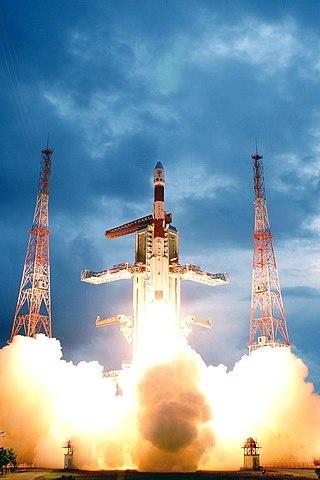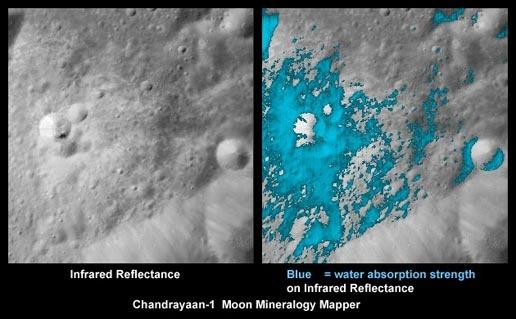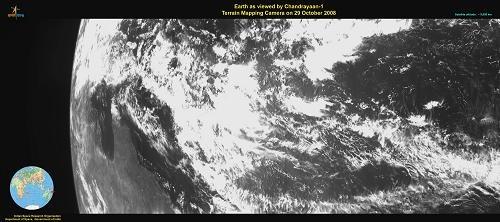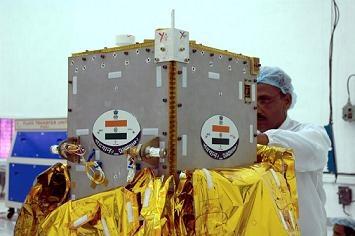
During the tenure of Prime Minister Manmohan Singh, the Chandrayaan project got a boost and finally Chandrayaan-1 was launched on 22October 2008 at 00:52 UTC from Satish Dhawan Space Centre using the ISRO's 44.4-metre (146 ft) tall, four-stage PSLV C11 launch vehicle. Chandrayaan-1 was sent to the Moon in a series of orbit-increasing manoeuvres around the Earth over a period of 21 days as opposed to launching the craft on a direct trajectory to the Moon. At launch the spacecraft was inserted into geostationary transfer orbit (GTO) with an apogee of 22,860 km (14,200 mi) and a perigee of 255 km (158 mi). The apogee was increased with a series of five orbit burns conducted over a period of 13 days after launch.
For the duration of the mission, ISRO's telemetry, tracking and command network (ISTRAC) at Peenya in Bangalore, tracked and controlled Chandrayaan-1. Scientists from India, Europe, and the U.S. conducted a high-level review of Chandrayaan-1 on 29 January 2009 after the spacecraft completed its first 100 days in space.
Earth orbit burns
| Date (UTC) | Burn time (minutes) |
Resulting apogee |
|---|---|---|
| 22 October Launch |
18.2 in four stages |
22,860 km |
| 23 October | 18 | 37,900 km |
| 25 October | 16 | 74,715 km |
| 26 October | 9.5 | 164,600 km |
| 29 October | 3 | 267,000 km |
| 4 November | 2.5 | 380,000 km |
- First orbit burn
The first orbit-raising manoeuvre of Chandrayaan-1 spacecraft was performed at 03:30 UTC on 23 October 2008 when the spacecraft's 440 Newton liquid engine was fired for about 18 minutes by commanding the spacecraft from Spacecraft Control Centre (SCC) at ISRO Telemetry, Tracking and Command Network (ISTRAC) at Peenya, Bangalore. With this Chandrayaan-1's apogee was raised to 37,900 km (23,500 mi), and its perigee to 305 km (190 mi). In this orbit, Chandrayaan-1 spacecraft took about 11 hours to go around the Earth once.
- Second orbit burn
The second orbit-raising manoeuvre of Chandrayaan-1 spacecraft was carried out on 25 October 2008 at 00:18 UTC when the spacecraft's engine was fired for about 16 minutes, raising its apogee to 74,715 km (46,426 mi), and its perigee to 336 km (209 mi), thus completing 20 percent of its journey. In this orbit, Chandrayaan-1 spacecraft took about twenty-five and a half hours to go round the Earth once. This was the first time an Indian spacecraft went beyond the 36,000 km (22,000 mi) high geostationary orbit and reached an altitude more than twice that height.
- Third orbit burn
The third orbit raising manoeuvre was initiated on 26 October 2008 at 01:38 UTC when the spacecraft's engine was fired for about nine and a half minutes. With this its apogee was raised to 164,600 km (102,300 mi), and the perigee to 348 km (216 mi). In this orbit, Chandrayaan-1 took about 73 hours to go around the Earth once.
- Fourth orbit burn
The fourth orbit-raising manoeuvre took place on 29 October 2008 at 02:08 UTC when the spacecraft's engine was fired for about three minutes, raising its apogee to 267,000 km (166,000 mi) and the perigee to 465 km (289 mi). This extended its orbit to a distance more than half the way to the Moon. In this orbit, the spacecraft took about six days to go around the Earth once.
- Final orbit burn
The fifth and final orbit raising manoeuvre was carried out on 3 November 2008 at 23:26 UTC when the spacecraft's engine was fired for about two and a half minutes resulting in Chandrayaan-1 entering the Lunar Transfer Trajectory with an apogee of about 380,000 km (240,000 mi).
Lunar orbit insertion
| Date (UTC) | Burn time (seconds) |
Resulting periselene |
Resulting aposelene |
|---|---|---|---|
| 8 November | 817 | 504 km | 7,502 km |
| 9 November | 57 | 200 km | 7,502 km |
| 10 November | 866 | 187 km | 255 km |
| 11 November | 31 | 101 km | 255 km |
| 12 November Final orbit |
100 km | 100 km |
Chandrayaan-1 completed the lunar orbit insertion operation on 8 November 2008 at 11:21 UTC. This manoeuvre involved firing of the liquid engine for 817 seconds (about thirteen and half minutes) when the spacecraft passed within 500 km (310 mi) from the Moon. The satellite was placed in an elliptical orbit that passed over the polar regions of the Moon, with 7,502 km (4,662 mi) aposelene and 504 km (313 mi) periselene. The orbital period was estimated to be around 11 hours. With the successful completion of this operation, India became the fifth nation to put a vehicle in lunar orbit.
- First orbit reduction
First Lunar Orbit Reduction Manoeuvre of Chandrayaan-1 was carried out on 9 November 2008 at 14:33 UTC. During this, the engine of the spacecraft was fired for about 57 seconds. This reduced the periselene to 200 km (124 mi) while aposelene remained unchanged at 7,502 km. In this elliptical orbit, Chandrayaan-1 took about ten and a half hours to circle the Moon once.
- Second orbit reduction
This manoeuvre was carried out on 10 November 2008 at 16:28 UTC, resulting in steep decrease in Chandrayaan-1's aposelene to 255 km (158 mi) and its periselene to 187 km (116 mi), During this manoeuvre, the engine was fired for about 866 seconds (about fourteen and a half minutes). Chandrayaan-1 took two hours and 16 minutes to go around the Moon once in this orbit.
- Third orbit reduction
Third Lunar Orbit Reduction was carried out by firing the onboard engine for 31 seconds on 11 November 2008 at 13:00 UTC. This reduced the periselene to 101 km (63 mi), while the aposelene remained constant at 255 km. In this orbit Chandrayaan-1 took two hours and 9 minutes to go around the Moon once.
- Final orbit
Chandrayaan-1 spacecraft was placed into a mission-specific lunar polar orbit of 100 km (62 mi) above the lunar surface on 12 November 2008. In the final orbit reduction manoeuvre, Chandrayaan-1's aposelene and periselene were both reduced to 100 km. In this orbit, Chandrayaan-1 takes about two hours to go around the Moon once. Two of the 11 payloads—the Terrain Mapping Camera (TMC) and the Radiation Dose Monitor (RADOM)—were switched on. The TMC acquired images of both the Earth and the Moon.
Source: https://en.wikipedia.org/wiki/Chandrayaan-1#Mission_timeline


